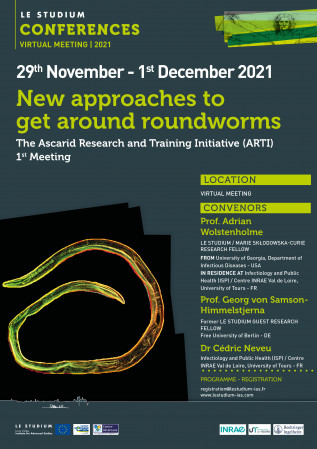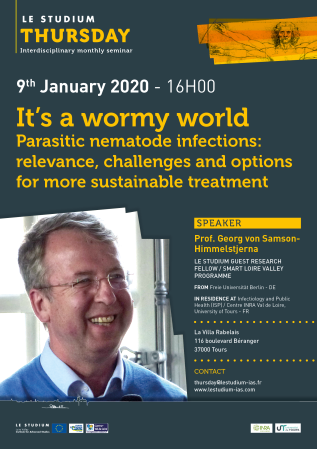Prof. Georg von Samson-Himmelstjerna

Établissement d'origine
Université libre de Berlin - DE
Laboratoire d'accueil
Infectiologie et Santé Publique (ISP) / Centre INRA Val de Loire , Université de Tours - FR
Hôte Scientifique
Dr Cédric Neveu
Publications
Final reports
Infections with parasitic helminths expose serious health threats to humans and animals alike. Prevention of disease is dependent on the effective treatment using anthelmintics. Unfortunately, anthelmintic resistance (AR) has evolved in many helminth species during the past decades and meanwhile poses a major constraint to established worm control approaches. This project aimed to improve our understanding of the molecular mechanisms by which helminths, particularly the potentially deadly horse parasite Parascaris sp., become capable of withstanding drug treatment. To this end, Parascaris P-glycoproteins (Pgp), belonging to an important group of mediators of anthelmintic resistance, were introduced into the model organism Caenorhabditis elegans using the CRISPR/Cas9 technology. The resulting transgenic lines will subsequently be analyzed to functionally elucidate the role of putatively AR-associated Parascaris Pgp sequence polymorphisms.
Helminth infections represent a major health threat for both humans and animals. In the latter they occur at often very high prevalences and on a global scale. Due to a near complete lack of immuno-prophylactic measures the metaphylactic use of chemotherapeutics i.e. the anthelmintics is the corner stone of worm control since decades. This has resulted in widespread anthelmintic resistance in a range of helminth species. Particularly the gastrointestinal nematodes and amongst them also so called roundworms or ascarids have evolved resistance. This results in an increasing clinical issue as like in horses the Parascaris spp. as well as in pigs or humans the Ascarais spp. often cause considerable clinical symptoms. To improve the sustainable use and provide solutions for the resistance problem it is important to understand the molecular mechanisms of anthelmintic resistance. In the present project the P-glycoprotein (Pgp) based drug efflux as a non-drug target associated mechanism of resistance is being addressed in Parascaris. To this end, the model nematode Caenorhabditis elegans was employed and the specific role of the Pgp3 was examined. The pharmacological profile of a Pgp3 knock out C. elegans line (VC 2338) was established using a panel of anthelmintic compounds and compared with the N2 wildtype strain. Furthermore, the Parascaris Pgp3 coding sequence was injected into the VC2338 to achieve recombinant expression under an intestinal promotor (ges1) as we have done it successfully with another Parascaris Pgp recently. Our results suggest that the Parascaris Pgp3 overexpression in C. elegans interferes with the development of the worm and ongoing investigations attempt to further elucidate the specific role of Pgp3 in the worms homoeostasis.


